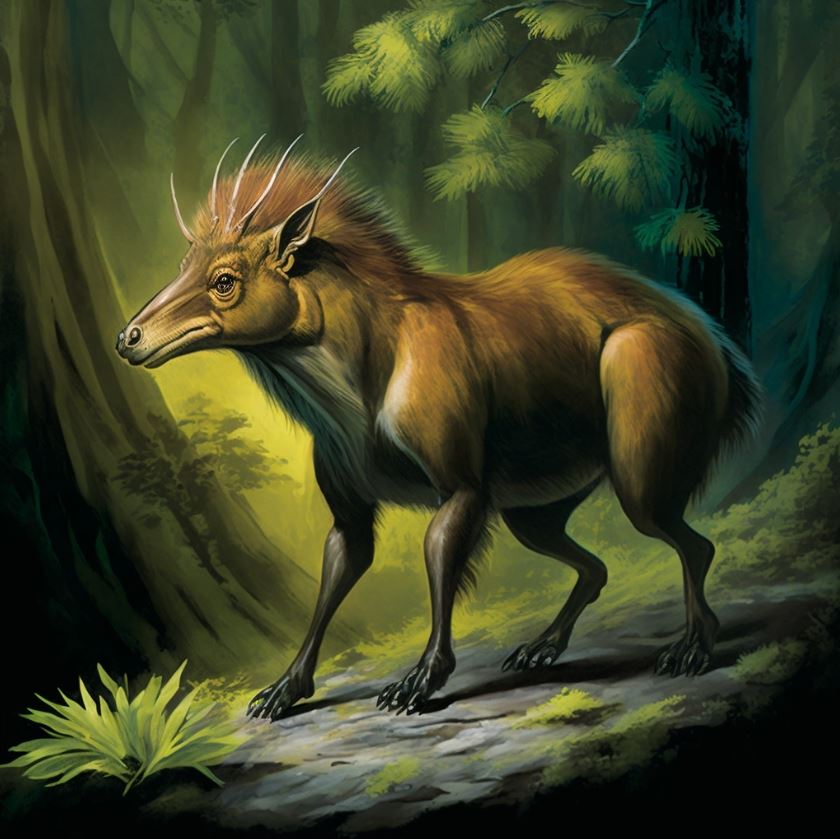Toque
Basic Information
Anatomy
The Toque is a herbivorous mammal that is characterized by its long, pointed ears and its bony crown-like structure on its head. It has a stout, powerful build, with three bony toes on each leg and a short tail. Its main and top fur is a warm, orange-brown color, while its legs are a dark, almost black shade. The Toque's chest and belly have some white fur, and its nostrils are located at the end of its long face. Its eyes have a protective membrane that helps protect them from environmental hazards.
Genetics and Reproduction
The Toque is a herbivorous mammal that reproduces sexually. They have a relatively short gestation period of about 6 months and typically give birth to one or two offspring at a time. The Toque's offspring are born fully developed and are able to forage for food on their own within a few weeks of birth. The Toque has a relatively long lifespan for a mammal of its size, with individuals living for up to 15 years in the wild. The Toque's genetics are similar to other mammals, with a typical complement of chromosomes and the ability to produce offspring with varying physical characteristics due to the combination of genes from their parents. The Toque has a relatively low rate of genetic diversity compared to some other species, but this has not had a significant impact on their population size or overall health.
Growth Rate & Stages
The Toque go through several growth stages as they develop from young to adult. In the early stages of life, they are dependent on their mothers for food and protection. As they grow, they become more independent and are able to forage for food on their own. During the adolescent stage, Toques develop their full size and strength, and begin to establish their place in the social hierarchy. As they reach adulthood, they become fully self-sufficient and are able to reproduce. The length of time it takes for a Toque to reach each stage of development varies, but generally, they reach maturity in about 3-5 years.
Ecology and Habitats
Toques are adapted to live in a variety of environments, including forests, savannas, and mountainous regions. They have powerful legs and toes that allow them to navigate rough terrain, such as rocky slopes or steep cliffs. In forests, Toques use their long snouts to forage for food, such as leaves, shoots, and fruit. In savannas, they may graze on grasses and other low-lying vegetation. In mountainous regions, they may have to climb to higher elevations to find food and shelter.
Deserts may be less suitable habitats for Toques, as their thick fur and body structure may not be well-adapted to extreme heat and dryness. They may struggle to find enough food and water to survive in desert environments, and the soft sand may make it difficult for them to move around efficiently. However, if there are areas of the desert with sufficient food and water, Toques may be able to adapt and establish a presence there.
Dietary Needs and Habits
The Toque is an herbivorous creature, feeding primarily on a variety of plants and vegetables. They have a preference for leaves, shoots, and stems, but may also consume fruit and seeds when available. They are able to extract nutrients from a wide range of plant material, including tough or fibrous plants that may be difficult for other herbivores to digest. In order to obtain their food, Toques may forage widely, using their powerful legs and agile bodies to climb or navigate challenging terrain. They may also use their keen senses and powerful jaws to locate and harvest food sources
Biological Cycle
In the winter, Toques grow thicker coats to help them stay warm and huddle together for added insulation. They are able to find food and water in these environments, and have a varied diet that includes a variety of plants and fruits.
Behaviour
Toques are generally peaceful creatures, but they can be territorial and will defend their herd if necessary. They are also intelligent and curious animals, often exploring their surroundings and seeking out new sources of food. Toques are empathetic and compassionate, showing concern for their herdmates and reacting to the emotions of others.
Additional Information
Perception and Sensory Capabilities
The Toque has keen senses, with sharp eyes that are able to see well in a variety of lighting conditions. Its eyes are protected by a membrane that helps it cope with harsh weather conditions. Its ears are pointed and able to detect even the slightest sounds, making it an effective predator and prey detector. Its sense of smell is also highly developed, allowing it to detect food and potential threats in its environment. The Toque also possesses a unique form of extrasensory perception that allows it to sense the presence and emotions of other beings in its surroundings. This ability is thought to be related to the bony structure on its head, which is believed to act as a kind of antenna that amplifies and focuses its extrasensory abilities.
Scientific Name
Mammal
Lifespan
15-20
Average Height
3-4 ft
Average Weight
130-160 lbs
Average Length
3.5-5 ft
Body Tint, Colouring and Marking
The Toques have a body coloring that is mostly a reddish-brown hue, with a lighter color on their chest and belly. They have a mane of fur on their head and neck that is a slightly darker shade of brown. Their legs are a dark, almost black color.
Geographic Distribution



Comments